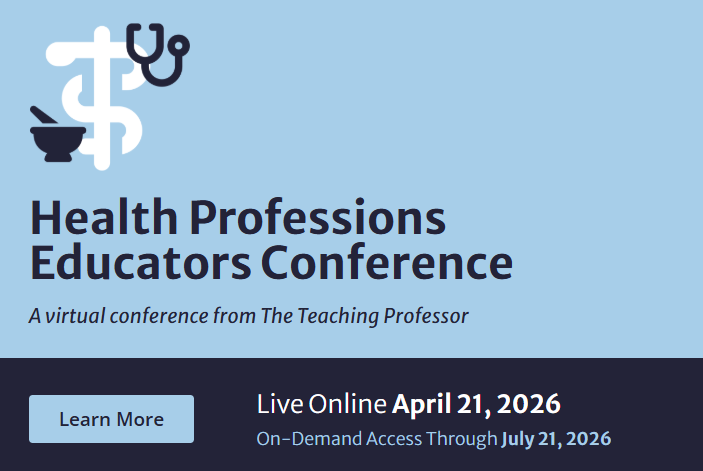For every college-level class that I have taught, I have always earned the highest score possible for being a quality professor, per my students’ course evaluations. How was this feasible my first year of teaching where I was often learning material just before I taught it to my students? As I embark on my 18th year of teaching, I have allowed myself a great deal of reflection on this topic. What makes students want to come to class? What makes them engaged and respectful? In my lived experience, it’s not necessarily the topics that drive students to show up and participate, it’s the effort and care that the professor puts into the course and into getting to know and to reach each of their students, individually.
My evaluations at the end of the semester do speak of my knowledge and organization, but more often than not, students comment on my being there for them, being kind, and making an effort to know them. What I teach is important, but more important are the connections that I make with my students that result in them wanting to come to class to learn. In an effort to explain what elements of my personality and teaching strategies and style result in respectful, engaged students who come to class, I drew upon research whose findings mirror my approach toward teaching for, not to, my students.
1. Get to know students’ names as soon as possible.
Research indicates that there is tremendous value in professors learning students’ names, with students believing that if a professor knows their name, there is less of a likelihood of being nervous when verbally participating in class (Bosch, 2023). At the start of each semester I print my roster which includes students’ university ID picture, and I take several minutes before each class to review their pictures and names until I have everyone’s name memorized (usually within the first 3-4 classes). I have found that learning students’ first and last names within the first two weeks is incredibly important for building rapport and ensuring that students feel valued, welcome, it’s important for them to class, and that I will notice if they’re not there, which I do. I email students who miss two classes in a row to check-in on them, which is often met with surprised appreciation and an explanation of how things are difficult for them outside of our class. This often sparks in-person conversation which in turn helps in building trust and increases class attendance with those students.
2. Employ fun, low-stakes icebreakers the first class and throughout the semester.
One study found that after engaging in icebreakers, high school seniors felt more connected with their peers, a stronger sense of community, and an improvement in their willingness to actively participate in discussions and activities in class. Further, engaging in routine icebreakers can aid with improving communication and teamwork, which are endlessly important, especially in today’s world (Sasan et al., 2023).
I not only employ ice breakers on the first day of class, but I also utilize them throughout the semester. I recently attended a conference where the presenters demonstrated several kinesthetic icebreakers that could engage and involve students without embarrassing them. One involved blindfolded classmates tossing pool noodles toward their peers and could not have been more of a hit when I implemented it a couple of weeks later in an otherwise quieter class of students. I utilized the icebreaker with a few weeks left of the semester and it sparked more conversation among students than any other activity had up to that point. I also regularly draw upon technology with implementing ice breakers, such as through Mentimeter. Students are like moths to a flame with technology, so this interests them, and allows everyone to participate in a low stakes manner.
3. Leave individualized feedback on all assignments.
This allows students to know that you are taking time to review and respond to each individual assignment, which they appreciate, as I have been told countless times. Through individualized feedback, students are provided the opportunity for the professor to let students know of their progress and achievement, rather than high stakes summative evaluations, which focus only on success or failure (Al-Bashir et al., 2016). Over time, formative assessments with individualized feedback encourages students to both learn from previous mistakes and to relish in their successes. Personalized, ongoing feedback for all assignments tends to result in greater compliance with submitting quality assignments in a timely manner.
4. Respond to emails in a timely manner.
Responding to emails in a timely manner lets students know that you are there for them, and helps them feel supported when they miss class, have a question, or need extra help. One study found that most students (91%) felt that instructors responding within 24 hours was an acceptable response timeline (Chang et al., 2016). I respond sooner than that within the framework of the workweek, with emails received during the weekend potentially not receiving a response until Monday morning, which students seem to respect and agree with.
5. Allow students to learn kinesthetically.
Many bodies of research indicate that for the majority of students, kinesthetic learning is their preferred modality. One study found that students chose demonstrations and interactive lectures as their preferred teaching method (Tamilarasan et al., 2023). I’ve found students to be more invested in content if demonstrations can be paired with lecturing, and if they have an opportunity to engage in those opportunities regularly. I lead a demonstration and provide hands-on opportunities for practicing knife skills, and using a grater, garlic press, and lemon squeezer to make salad dressing to accompany a lecture on nutrition. I lead students in breathing exercises, yoga, meditation, and progressive muscle relaxation to accompany a lecture on stress management techniques. Most people learn best by doing, and students are no exception to that rule.
6. Regularly create opportunities for in-class small group work.
Having students work in small groups has been shown to promote better student outcomes, even in large lecture classes. When requiring students to work in small groups during class, it is important for the instructor to consider why they are doing so and how it meets the learning goals for the class. In an effort to promote student buy-in and participation in group work, these goals should be shared with students when providing directions and expectations. It should also be noted that group work that piques students’ interests can improve their motivation and productivity when working in groups (Wilson et al., 2018). If an assignment corresponds to goals that align with outcomes for the course, if appropriate directions are provided and explained, and if expectations are clear about contributing to small group work, it creates additional chances for students to share and engage, and allows instructors time to chat with and provide oral feedback for students they might not otherwise have the opportunity to engage with in that manner.
7. Respect your students.
In one study of upper-level high school students, when discussing examples of respect with their teachers, students cited teachers showing care and concern for students’ personal lives and their academic success. Results indicated that students identify behaviors that are associated with caring as being respectful (Singer & Audley, 2017). If you truly care for your students, they will notice, and you will gain their respect. This sets the stage for relationships built on trust which results in strong attendance, participation in class, and success in the course.
8. Show students you are there for them as often as possible. If it seems like too much, do it more.
Students who feel cared for by their professor may put more effort into their coursework (Dickinson & Kreitmair, 2021). But, more importantly, students who feel cared for by their professor feel cared for by their professor, and that may make a world of difference to one person.
Jennifer McMullen received her PhD from the University of Kentucky in 2016. Her research interests include college-based nutrition/cooking programming, promoting physical activity across the lifespan, and health and wellness coaching. Dr. McMullen teaches undergraduate and graduate courses in Exercise Science and Health Promotion at the University of Kentucky.
References
Al-Bashir, M. Kabir, R., & Rahman, I. (2023). The value and effectiveness of feedback in improving students’ learning and professionalizing teaching in higher education. Journal of Education and Practice, 7(16), 38-41. https://files.eric.ed.gov/fulltext/EJ1105282.pdf
Bosch, B. (2023). Does being known matter? Analyzing the effects of name recognition by instructor and student. (Publication No. 814). [Doctoral dissertation, University of Nebraska-Lincoln]. Faculty Publications.
Chang, C-W., Hurst, B., & McLean, A. (2016). How fast is fast enough? Education students’ perceptions of email response time in online courses. Journal of Educational Technology Development and Exchange, 9(1), 1-11). https://aquila.usm.edu/jetde/vol9/iss1/1/#:~:text=The%20results%20of%20the%20survey,receive%20from%20their%20online%20instructors.
Dickinson, A.R. & Kreitmair, U.W. (2021). The importance of feeling cared for: Does a student’s perception of how much a professor cares about student success relate to class performance? Journal of Political Science Education, 17(3), 356-370. https://www.tandfonline.com/doi/full/10.1080/15512169.2019.1659803
Sasan, J.M., Tugbong, G.M., & Alistre, K.C. (2023). An exploration of icebreakers and their impact on student engagement in the classroom. International Journal of Social Service and Research, 3(11), 2921-2930. https://doi.org/10.46799/ijssr.v3i11.566
Singer, A.F & Audley, S. (2017). “Some teachers just simply care”: Respect in urban student-teacher relationships. Journal of Critical Education Policy Studies at Swarthmore College, 2 (1). doi: 10.24968/2473-912X.2.1.5
Tamilarasan, M., Karthikeyan, K., Malik, A., Rizvana, S., Janet S., Shrimathi, A., Sindhurajeswari, R., Sivaranjani, A., & Sowmiya, J. (2023). Learning styles and their relationship with preferred teaching methodologies and academic achievement among medical students in teaching medical college, Tamil Nadu. Journal of Health Education and Health Promotion, 12(1), 256. doi: 10.4103/jehp.jehp_185_23
Wilson, K.J., Brickman, P., Brame, C.J (2018). Group work. CBE: Life Sciences Education, 17(1). doi: 10.1187/cbe.17-12-0258.






